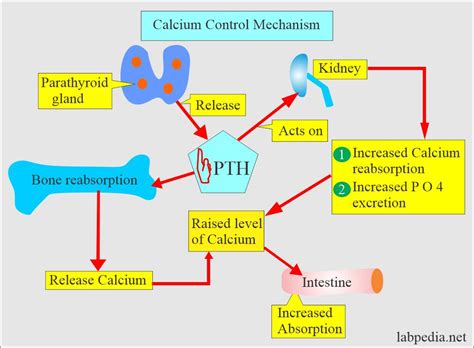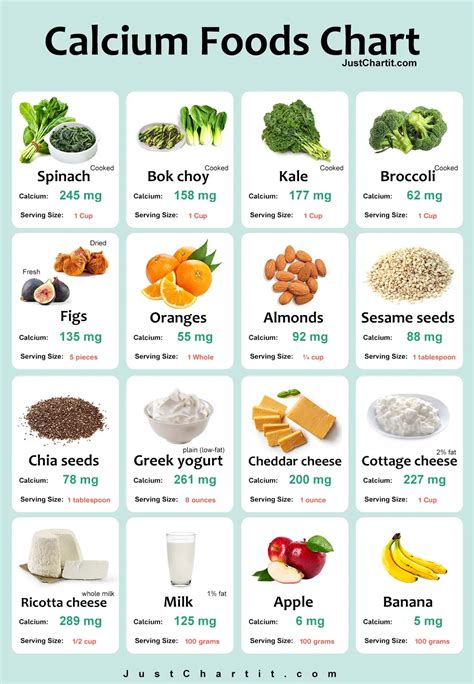Intro
Discover foods high in calcium, including dairy, leafy greens, and fortified options, to support strong bones and overall health with essential calcium-rich nutrients and minerals.
Calcium is an essential mineral that plays a critical role in maintaining strong bones and teeth, as well as supporting various bodily functions such as muscle function and nerve function. A diet rich in calcium can help prevent conditions like osteoporosis, which can lead to brittle bones and increased risk of fractures. With so many delicious and calcium-rich foods available, it's easy to incorporate this vital mineral into your daily meals. In this article, we'll delve into the world of calcium-rich foods, exploring the benefits, working mechanisms, and practical examples to help you make informed dietary choices.
A well-balanced diet that includes a variety of calcium-rich foods can have a significant impact on overall health and wellbeing. Calcium deficiency, also known as hypocalcemia, can lead to a range of health problems, including weak bones, muscle cramps, and fatigue. By consuming foods high in calcium, individuals can reduce their risk of developing these conditions and maintain optimal health. Additionally, a calcium-rich diet can also support healthy weight management, as calcium has been shown to aid in fat burning and weight loss.
Calcium is not only essential for maintaining strong bones and teeth, but it also plays a critical role in various bodily functions. For example, calcium helps regulate muscle function, including the heartbeat, and supports nerve function, which enables the transmission of nerve impulses. Furthermore, calcium is involved in the activation of enzymes, which are essential for various metabolic processes. With so many vital functions relying on calcium, it's clear that a diet rich in this mineral is essential for maintaining optimal health.
Benefits of Calcium-Rich Foods

The benefits of calcium-rich foods are numerous and well-documented. Some of the most significant advantages of consuming a calcium-rich diet include:
- Stronger bones and teeth: Calcium is essential for maintaining strong bones and teeth, and a diet rich in this mineral can help prevent conditions like osteoporosis.
- Improved muscle function: Calcium helps regulate muscle function, including the heartbeat, and supports nerve function, which enables the transmission of nerve impulses.
- Weight management: Calcium has been shown to aid in fat burning and weight loss, making it an essential mineral for those looking to manage their weight.
- Reduced risk of chronic diseases: A diet rich in calcium has been shown to reduce the risk of chronic diseases, including heart disease, type 2 diabetes, and certain types of cancer.
Top Calcium-Rich Foods
Some of the richest sources of calcium include: * Dairy products: Milk, cheese, and yogurt are all excellent sources of calcium. * Leafy greens: Leafy greens like kale, broccoli, and spinach are rich in calcium and other essential nutrients. * Fortified foods: Many foods, including cereals and orange juice, are fortified with calcium, making them excellent sources of this mineral. * Tofu and other soy products: Tofu and other soy products are rich in calcium and are excellent alternatives to dairy products for those with dietary restrictions.Working Mechanisms of Calcium

Calcium works by being absorbed into the bloodstream, where it can be used by the body to support various functions. The absorption of calcium is facilitated by vitamin D, which is essential for maintaining strong bones and teeth. When calcium is ingested, it is broken down into smaller particles, which can then be absorbed into the bloodstream. The calcium is then transported to the bones, teeth, and other tissues, where it can be used to support various functions.
Steps to Increase Calcium Intake
Increasing calcium intake is relatively straightforward and can be achieved by following these simple steps: 1. Eat more dairy products: Milk, cheese, and yogurt are all excellent sources of calcium. 2. Incorporate leafy greens into your diet: Leafy greens like kale, broccoli, and spinach are rich in calcium and other essential nutrients. 3. Choose fortified foods: Many foods, including cereals and orange juice, are fortified with calcium, making them excellent sources of this mineral. 4. Consider supplements: If you're struggling to get enough calcium from your diet, consider taking a supplement.Practical Examples of Calcium-Rich Foods

Some practical examples of calcium-rich foods include:
- A bowl of fortified cereal with milk for breakfast
- A salad with leafy greens, such as kale or spinach, for lunch
- A glass of milk or a cup of yogurt as a snack
- A serving of tofu or other soy products for dinner
Statistical Data on Calcium Intake
According to the National Institutes of Health, the recommended daily intake of calcium is 1,000 mg for adults aged 19-50 and 1,200 mg for adults over 50. However, many people fail to meet these recommendations, with the average adult consuming only around 800-900 mg of calcium per day. This can lead to a range of health problems, including weak bones and increased risk of fractures.FAQs on Calcium-Rich Foods

What are the benefits of calcium-rich foods?
+The benefits of calcium-rich foods include stronger bones and teeth, improved muscle function, weight management, and reduced risk of chronic diseases.
What are some examples of calcium-rich foods?
+Examples of calcium-rich foods include dairy products, leafy greens, fortified foods, and tofu and other soy products.
How can I increase my calcium intake?
+You can increase your calcium intake by eating more dairy products, incorporating leafy greens into your diet, choosing fortified foods, and considering supplements.
Conclusion and Final Thoughts

In conclusion, calcium is an essential mineral that plays a critical role in maintaining strong bones and teeth, as well as supporting various bodily functions. By incorporating calcium-rich foods into your diet, you can reduce your risk of developing conditions like osteoporosis and maintain optimal health. Remember to eat a variety of calcium-rich foods, including dairy products, leafy greens, fortified foods, and tofu and other soy products. With a little creativity and planning, you can easily meet your daily calcium needs and enjoy the many benefits that come with a calcium-rich diet.
We hope this article has provided you with a comprehensive understanding of the importance of calcium-rich foods and how to incorporate them into your diet. If you have any questions or comments, please don't hesitate to share them with us. Additionally, if you found this article informative and helpful, please consider sharing it with your friends and family who may benefit from learning about the benefits of calcium-rich foods. Together, we can promote healthy eating habits and support overall wellbeing.
